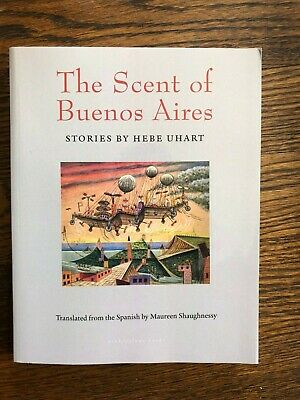The Scent of Buenos Aires by Hebe Uhart: Review by Meilee Anderson
I normally tear through books at a blistering pace but not this one. I spent a week lingering over each of the 25 short stories in The Scent of Buenos Aires. I was carried away from my quarantine life to a far-away country. The stories in this book made me laugh twice, smile often, cringe a few times, and day dream about the characters for days.

As I read the stories, I noticed how the women treated each other, how they treated the people in their lives, and how they were treated. The Scent of Buenos Aires shines a spotlight on the quirks of people during random moments in their lives. We meet cranky, curious, kind, stern, and friendly women of all ages. Amongst the pages we travel to the rural countryside, a salon, a woman’s patio, an HOA meeting that goes awry (don’t they all?) and more.
This is the first collection of Hebe Uhart’s work to be translated from Spanish to English. Hebe was a teacher and an award-winning author. She died in 2018 at the age of 81. I can see why Hebe Uhart is a beloved Argentine author. She knew women. Uhart had a gift for writing stories about the inner life of crazy, eccentric, and curious women. From what I’ve read about Hebe she strikes me as a woman a wry sense of humor who had no qualms about reading the room and calling things as she saw them.
Sadly, my Spanish is too rusty for me to tackle other short stories from Ms. Uhart. I will have to wait and hope that more of her work is translated to English.
Find The Scent of Buenos Aires Here
Goodreads: Get it here
Print: Get it here.
Hebe Uhart: Author’s Bio
Born in 1936 in the outskirts of Buenos Aires, Hebe Uhart is one of Argentina’s most celebrated modern writers. She published two novels, Camilo asciende (1987) and Mudanzas (1995), but is better known for her short stories, where she explores the lives of ordinary characters in small, Argentine towns. Her Collected Stories won the Buenos Aires Bookfair Prize (2010), and she received Argentina’s National Endowment of the Arts Prize (2015) for her trajectory as well as the Manuel Rojas Ibero-American Narrative Prize (2017).
Her writing, which presents a characteristically criollo language, is identified with a quirky, understated syntax that constructs an odd perspective on the quotidian life in South America. Rodolfo Enrique Fogwill, author of Malvinas Requiem, named her the “greatest contemporary Argentine writer.” About her writing, scholar and essayist Ricardo Piglia said: “I am not interested in satisfied writers. The best tradition of Argentinean literature is built through vacillations, through that ambiguous narrator that can be found in Hebe Uhart or Borges, where meaning is never fully constructed and is opposed to other traditions in which the narrators are convinced of the universe’s structural order.”




